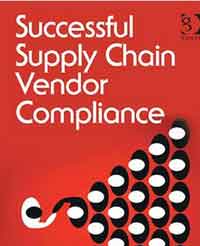UpcomingVideocast: Successful Supply Chain Vendor Compliance - for Retailers and Beyond
SCDigest is pleased to announce an upcoming new Videocast on successful vendor compliance – featuring Norman Katz, author of the new book Successful Supply Chain Vendor Compliance.
We reviewed Katz's excellent book on the pages of the Retail Vendor Performance Management Bulletin earlier this year, but in this broadcast we will be able to get into far more detail, as Katz and SCDigest editor Dan Gilmore discuss key issues around compliance program success.
Supply Chain Digest Says... |
 |
| According to Connell, Macy's has been expanding steadily into categories beyond apparel, and has found that the technology delivers value throughout its stores. |
 |
|
|
In this outstanding Videocast, Katz will summarize key elements of his book. Highlights of the broadcast will include:
• Why it's time for this book right now
• Compliance program guiding principles
• What is permissible under the law relative to vendor chargebacks?
• Common mistakes companies make in rolling out and maintaining vendor compliance programs
• Why retailers are often their own worst vendor compliance enemies
• The many "E's" of successful vendor compliance, from "Envision" to "Ethics"
Not to be missed for those interested in starting or improving vendor compliance programs.
Visit the Retail Vendor Performance Management home page to learn more
and subscribe to the monthly newsletter.
 Compliance Networks CEO Greg Holder will join the end of the broadcast to share his experience with what makes for successful compliance programs. Compliance Networks CEO Greg Holder will join the end of the broadcast to share his experience with what makes for successful compliance programs.
Complete details and the on-line registration form for this complimentary broadcast can be found here.
Macy's Doubles Down on RFID Commitment
At a recent industry conference, Bill Connell, Macy's senior VP of logistics and operations, revealed that his company plans to have 100% of all items in every store tagged by the end of 2017. To achieve this goal, the retailer is asking all of its product vendors to supply merchandise already fitted with passive ultrahigh-frequency (UHF) RFID tags based on the EPC Gen 2 standard.
"We still have a lot of work to do with our suppliers to get that joint commitment to apply tags at source," Connell said. "But we are fully prepped and continue to expand [our use of RFID]. We are now moving into additional use cases that are enabled because of RFID and, equally important - because of the availability of accurate information - on a very quick basis."
In 2015, Macy's announced that it was expanding its RFID-tagging deployment to all lines of businesses at its stores, except for jewelry and cosmetics. These two categories were not a focus since there were challenges finding tags that worked effectively and would not negatively impact the items' presentation. "We are now working with GS1 and others to find solutions [for these categories]," Connell said, "both in the technology and the presentation techniques to bring those categories of business into the fold as well." However, he noted, there is a chance that Macy's will not be able to resolve those issues in time to meet the end-of-2017 goal.
By the end of this year or the start of 2017, Connell told attendees, more than 60% of all goods at most of Macy's stores will be RFID-tagged and cycle-counted monthly via handheld RFID readers. Macy's had published the tagging requirement in its vendor standards manual, he said. Now, the retailer is working with suppliers to get them to tag merchandise at its source.
There is a "much greater acceptance and greater understanding of the benefits" among suppliers, Connell explained. "There is a momentum that suggests to us that we are pretty much at that tipping point."
According to Connell, Macy's has been expanding steadily into categories beyond apparel, and has found that the technology delivers value throughout its stores. "We're finding that in home [products], it has a great deal of applicability," he said. "In areas where there are samples, like tabletop, those are further expansions."
Replenishing more effectively was the use case that got Macy's involved in RFID, Connell told the audience, but the company also found additional benefits, as many experts had suggested. "You find this natural ability to expand and do additional things that have a big impact on sales and profitability," he said. "And, I assure you, we track, through control testing and so forth, our performance in these categories quite consistently. We have been quite pleased with the results, both operationally and from a financial perspective."
Of course, vendor source tagging with RFID creates a whole new set of requirements relative to tag quality, proper encoding, and more, all of which must be monitored for compliance. RFID tagging may also allow much easier confirmation of ASN accuracy in mixed-SKU cartons.
Amazon's Total Share of ecommerce May be Larger than Estimated
The share of US ecommerce business that may be flowing through Amazon could be as high as 30% and growing, according to new estimates from the investment analysts at Piper Jaffray. That would be almost double the 15% share that most analysts have calculated, based on Amazon's reported sales numbers and Dept. of Commerce data on on-line sales.
But those Amazon sales numbers do not include the retail sales value of items moving through Amazon's marketplace services, in which consumers buy products on Amazon's site from third-party retailers, for which Amazon makes a small commission, generally about 10%. So the total value of merchandise purchased on Amazon's site in the US could be as much as $125 billion already.
An article in the USA Today newspaper says some 49% of total sales through Amazon.com come from such third-party marketplace vendors.
Your Comments/Feedback
|